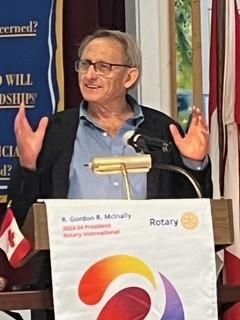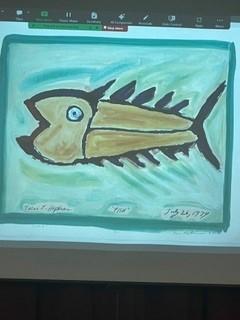“Eyes of an artist, words of a poet, mind of a scientist.”
Written by Mimi Edmunds
Celebrated local artist Eric Hopkins recently came to West Bay Rotary’s Thursday morning breakfast meeting to share his thoughts on what drives his art these days, what he cares about, and what continues to move him to create in all forms. With unabashed enthusiasm, he shared the connections he feels with his community through generations and as an artist to create and express those connections. Today, the driving motivator for him is about “legacy.”
Hopkins believes that legacy builds and strengthens communities by leaving something behind. “For me it’s important to look at the legacy people leave,” he says. He quickly adds that we should even look at cave art to really understand the importance of legacy. “I have a direct connection to that!” he says.
Eric Hopkins’ legacy in Vinalhaven goes back to his great grandfather, Theopolis Hopkins. Many years ago Theopolis worked in the Camden shipyard and was one of the original settlers in America. He received Vinalhaven land as compensation from the new government, and he became a doctor, had four wives, successfully populating the island with 28 children! Finally, Eric added, Theopolis was good friends with another early settler, Frank Rankin.
When the Russians launched Sputnik in 1957, Hopkins recalls it as a “wow” moment, when his universe suddenly widened and the whole world changed. This shift in awareness gave him a sense of place in the world, part of a larger global community. It continued with President Kennedy’s pronouncement that America would land a man on the moon within a decade. So when Neil Armstrong became that man in 1969, Hopkins was so inspired he declared “if we could put a man on the moon, I could do anything I wanted!” He saw that his work could have a larger audience while also being moved by the art of another Maine artist, Louise Nevelson, realizing that art could be of common, ordinary things.
Hopkins told the story of catching his first fish and then painting over it with his now trademark vivid colors. He showed it to his mother, whose immediate response was, “it stinks, throw it away.” Disappointed by her reaction, he threw away the fish. At the time, his father was dying and that got him thinking about death and life and connection. He regretted throwing away the fish, realizing he had a connection with it, his first fish, just as he had a connection with his father who had been a live force in his life.
Hopkins spoke to the theme of legacy being so important to him at this point in his life by talking about the family members he has lost: his brother Steven when he was only 10; his father around the time he was breaking into his art; and then, when he was trying to recover and make sense of his life with these losses, his 20-year-old son was killed in a car accident. Hopkins opened up about the profound impact of his son’s death, recounting a dream he had of his son writing to his father a letter telling him to “fly,” take risks, do more, do better, believe in himself. Hopkins has come to realize that all his losses have only highlighted the connections with his community, his family, his home, the sea, the islands, and that his job was to carry on that legacy as an artist, using light, color, music, motion, painting through words, glass, and wood.
Growing up in the middle of the Penobscot Bay, it’s still the center of the universe for Hopkins, where he wakes up every morning and looks out the window and says, “what a world, look at this bay, where it meets the horizon.” It is the landscape that inspires and influences his art in its colors, shapes, and patterns in nature. Art that is unique, living, and dynamic… his legacy.
































